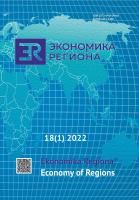Выявление моделей индустриально-инновационного развития региональных экономических систем
Identification of Industrial and Innovative Development Models of Regional Economic Systems
Author(s): Yury Anatolievich Doroshenko, Maria Sergeevna Starikova, Viktoria Ryapukhina Subject(s): Economy, National Economy, Business Economy / Management
Published by: Институт экономики Уральского отделения Российской академии наук
Keywords: innovation; industry;regional management; innovative development; industrial development; new industrialisation; industrialisation level; innovation performance; industrial and innovative development;
Summary/Abstract: New industrialisation challenges, turbulent economic environment and opening market niches change the structure of competitiveness factors and determine the innovativeness of industrial development. In the current context, it is necessary to deepen the analysis of industrialisation and innovation performance of regions. Therefore, this study aims to identify industrial and innovative development models present in Russian regions. To this end, we propose a methodology based on assessing the localisation coefficients of both regional industrialisation and innovation performance. Calculation of these indicators resulted in the creation of four models: Model 1 (low industrial development and low innovation performance), Model 2 (low industrial development and high innovation performance), Model 3 (high industrial development and high innovation performance), Model 4 (high industrial development and low innovation performance). The classification of the constituent entities of the Russian Federation according to the industrial and innovative development model shows that more than 40 % of regions use Model 1 and about 12 % of territories use Model 2. Simultaneously, approximately 27 % of regions (including Tula, Lipetsk, Chelyabinsk, Vladimir oblasts, Republic of Bashkortostan) chose Model 3, which most fully meets the new industrialisation challenges. The high stability of this disproportionate structure indicates the absence of positive dynamics and poor balance of industrial and innovation policy measures in most Russian regions in the period 2015–2019. The study results can be used to create an alternative ranking of innovative development of regions. Further research can apply these findings to assess the efficiency of regional industrial and innovation policies.
Journal: Экономика региона
- Issue Year: 18/2022
- Issue No: 1
- Page Range: 78-91
- Page Count: 14
- Language: Russian

